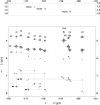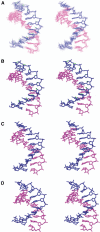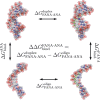Differential stability of 2'F-ANA*RNA and ANA*RNA hybrid duplexes: roles of structure, pseudohydrogen bonding, hydration, ion uptake and flexibility
- PMID: 20071751
- PMCID: PMC2853132
- DOI: 10.1093/nar/gkp1225
Differential stability of 2'F-ANA*RNA and ANA*RNA hybrid duplexes: roles of structure, pseudohydrogen bonding, hydration, ion uptake and flexibility
Abstract
Hybrids of RNA with arabinonucleic acids 2'F-ANA and ANA have very similar structures but strikingly different thermal stabilities. We now present a thorough study combining NMR and other biophysical methods together with state-of-the-art theoretical calculations on a fully modified 10-mer hybrid duplex. Comparison between the solution structure of 2'F-ANA*RNA and ANA*RNA hybrids indicates that the increased binding affinity of 2'F-ANA is related to several subtle differences, most importantly a favorable pseudohydrogen bond (2'F-purine H8) which contrasts with unfavorable 2'-OH-nucleobase steric interactions in the case of ANA. While both 2'F-ANA and ANA strands maintained conformations in the southern/eastern sugar pucker range, the 2'F-ANA strand's structure was more compatible with the A-like structure of a hybrid duplex. No dramatic differences are found in terms of relative hydration for the two hybrids, but the ANA*RNA duplex showed lower uptake of counterions than its 2'F-ANA*RNA counterpart. Finally, while the two hybrid duplexes are of similar rigidities, 2'F-ANA single strands may be more suitably preorganized for duplex formation. Thus the dramatically increased stability of 2'F-ANA*RNA and ANA*RNA duplexes is caused by differences in at least four areas, of which structure and pseudohydrogen bonding are the most important.
Figures







Similar articles
-
The solution structure of double helical arabino nucleic acids (ANA and 2'F-ANA): effect of arabinoses in duplex-hairpin interconversion.Nucleic Acids Res. 2012 Oct;40(18):9329-39. doi: 10.1093/nar/gks672. Epub 2012 Jul 14. Nucleic Acids Res. 2012. PMID: 22798499 Free PMC article.
-
Solution structure of an arabinonucleic acid (ANA)/RNA duplex in a chimeric hairpin: comparison with 2'-fluoro-ANA/RNA and DNA/RNA hybrids.Nucleic Acids Res. 2001 Nov 1;29(21):4284-93. doi: 10.1093/nar/29.21.4284. Nucleic Acids Res. 2001. PMID: 11691916 Free PMC article.
-
2'-Deoxy-2'-fluoro-beta-D-arabinonucleosides and oligonucleotides (2'F-ANA): synthesis and physicochemical studies.Nucleic Acids Res. 2000 Sep 15;28(18):3625-35. doi: 10.1093/nar/28.18.3625. Nucleic Acids Res. 2000. PMID: 10982885 Free PMC article.
-
2'-Fluoro-arabinonucleic Acid (FANA): A Versatile Tool for Probing Biomolecular Interactions.Acc Chem Res. 2021 May 4;54(9):2287-2297. doi: 10.1021/acs.accounts.1c00125. Epub 2021 Apr 16. Acc Chem Res. 2021. PMID: 33861067 Review.
-
Stabilities of double- and triple-strand helical nucleic acids.Prog Biophys Mol Biol. 1992;58(3):225-57. doi: 10.1016/0079-6107(92)90007-s. Prog Biophys Mol Biol. 1992. PMID: 1380719 Review.
Cited by
-
Synthesis and properties of 2'-deoxy-2',4'-difluoroarabinose-modified nucleic acids.J Org Chem. 2015 Mar 20;80(6):3083-91. doi: 10.1021/jo502948t. Epub 2015 Mar 5. J Org Chem. 2015. PMID: 25723361 Free PMC article.
-
Stabilization of i-motif structures by 2'-β-fluorination of DNA.Nucleic Acids Res. 2016 Jun 20;44(11):4998-5009. doi: 10.1093/nar/gkw402. Epub 2016 May 10. Nucleic Acids Res. 2016. PMID: 27166371 Free PMC article.
-
Synthesis and Antisense Properties of 2'β-F-Arabinouridine Modified Oligonucleotides with 4'-C-OMe Substituent.Molecules. 2018 Sep 17;23(9):2374. doi: 10.3390/molecules23092374. Molecules. 2018. PMID: 30227644 Free PMC article.
-
Measurement and theory of hydrogen bonding contribution to isosteric DNA base pairs.J Am Chem Soc. 2012 Feb 15;134(6):3154-63. doi: 10.1021/ja210475a. Epub 2012 Feb 2. J Am Chem Soc. 2012. PMID: 22300089 Free PMC article.
-
Beyond ribose and phosphate: Selected nucleic acid modifications for structure-function investigations and therapeutic applications.Beilstein J Org Chem. 2021 Apr 28;17:908-931. doi: 10.3762/bjoc.17.76. eCollection 2021. Beilstein J Org Chem. 2021. PMID: 33981365 Free PMC article. Review.
References
-
- Trempe JF, Wilds CJ, Denisov AY, Pon RT, Damha MJ, Gehring K. NMR solution structure of an oligonucleotide hairpin with a 2′F-ANA/RNA stem: implications for RNase H specificity toward DNA/RNA hybrid duplexes. J. Am. Chem. Soc. 2001;123:4896–4903. - PubMed
-
- Damha MJ, Wilds CJ, Noronha A, Brukner I, Borkow G, Arion D, Parniak MA. Hybrids of RNA and arabinonucleic acids (ANA and 2′F-ANA) are substrates of Ribonuclease H. J. Am. Chem. Soc. 1998;120:12976–12977.
-
- Noy A, Perez A, Marquez M, Luque FJ, Orozco M. Structure, recognition properties, and flexibility of the DNA-RNA hybrid. J. Am. Chem. Soc. 2005;127:4910–4920. - PubMed
-
- Noy A, Luque FJ, Orozco M. Theoretical analysis of antisense duplexes: determinants of the RNase H susceptibility. J. Am. Chem. Soc. 2008;130:3486–3496. - PubMed
Publication types
MeSH terms
Substances
Grants and funding
LinkOut - more resources
Full Text Sources
Other Literature Sources
Miscellaneous

